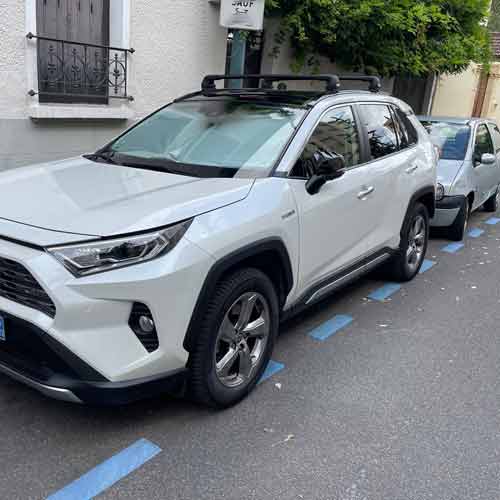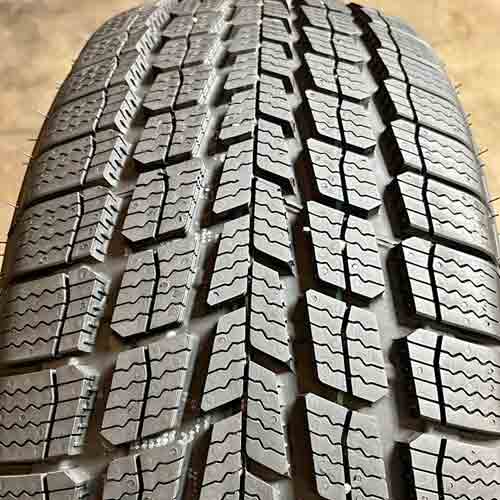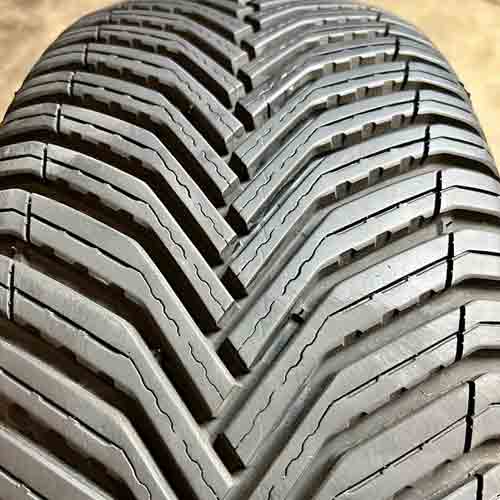Both the Firestone WeatherGrip and Michelin Crossclimate 2 are standout all-season tires, each with unique strengths and distinct features. Let’s put them head-to-head and see who reigns supreme in all types of conditions.

The Michelin Crossclimate 2 excels in dry braking and snowy conditions, offers superior wet grip and handling, and is generally quieter. In contrast, the Firestone WeatherGrip offers better lateral dry grip, performs well on icy surfaces, and has a “slight” advantage in tread longevity, and fuel economy.
Table of Contents
Available Tire Sizes and their Specs
The Firestone WeatherGrip comes in 15 to 19 inches sizes, and all of those have the following specs.
- Speed ratings: H and V.
- Load ratings: SL and XL.
- Tread depth: 10/32″ on all.
- Weight range: 17 to 30 lbs.
- Treadwear warranty: 65k miles.
- UTQG rating: 640 AA.
On the other side, the Michelin Crossclimate 2 comes in 16 to 22 inches with following specs.
- Speed ratings: H and V.
- Load ratings: SL and XL.
- Tread depth range: 10.5/32″ (on all)
- Weight range: 25 to 36.5 lbs
- Tread mileage rating: 60k miles.
- UTQG: 640 B A.
Also note that both tires have 3 peak mountain snowflake (3PMSF) and M+S ratings.
Tread Pattern Differences
The WeatherGrip although offers a directional pattern, there aren’t any swooping lugs.

The overall tread is pretty voided up, where 4 spacious circumferential grooves are interconnected with each other, laterally.
Though still to maintain stability, all these lugs are placed on a continuous running ribs underneath.
Speaking of stability, the central most area is made continuous running (barely). So they make unbroken contact with the road.
Here lugs are the smallest, yet, their edges, and snow-vices result in a good enough bite. And yes of course, there’s a ton of siping on them too.
The adjacent ribs, carry similar siping pattern (wave-like structure), though they also have longitudinal slits on them as well.
And same goes for shoulders, though they also carry snow vices and are bulkier comparatively.
Internally, the tire features a single ply polyester casing supporting two steel belts, and a there’s also a nylon cap ply on top.
On the other hand, the Crossclimate 2, unlike its competitor comes with a more streamlined directional pattern.

Here proper V shaped lugs are divided in to 2 sections, where the shoulders are the most voided up.
These shoulders (separated by longitudinal slits), only have linear lateral siping on them. So they are very simple.
On the other hand, the internal lugs carry snow vices, and a combination of dual siping designs.
I mean see how linear sipes then turn in to wave-like patterns as you go towards the middle.
Speaking of which, see how lugs are the most compacted up there, in the very middle.
This combined with their interlocking design, provide superb grip.
Internally the tire offers 2 ply polyester casing with 2 steel belts and a polyamide cap ply.
Dry Performance
Dry performance can be assessed using three key metrics: steering response, dry grip, and lateral traction. Let’s check out all of these aspects for a comprehensive understanding.
Directional Grip
Directional grip is quantified through stopping distances, measured when the tire is fully braked from a designated speed.
And here factors such as tread composition, rubber-to-road contact area (particularly form middle), weight, and rolling resistance collectively determine the overall grip level.
Now out of both tires, it makes sense why the Michelin Crossclimate 2 offers better dry grip, as seen by its braking distance test.
The tire not as voided up as the WeatherGrip, where its rounded contact patch further adds to that.
When compared with Crossclimate 2, the Firestone trails by almost 10 feet in braking tests. Though, considering its price point, this performance level can still be deemed acceptable.
Lateral Grip
The overall lateral grip of a tire is primarily influenced by its shoulders and sidewalls. This is because as the tire turns, the weight on it shifts towards the opposite side of the turn, causing the shoulders to make the most contact with the road.
Logically, since the shoulders aren’t overly voided and have reinforced foundational supports beneath them, it makes sense why the Firestone does better here, as evidenced by lateral g-force measurements.
But don’t get me wrong. I mean sure Michelin Crossclimate 2 although lacks with its voided up shoulders and greater tread depth relatively, it still maintains good enough road contact due to its minimalistic tread features.
(Basically less tread features mean more rubber real estate available to contact the road).
That’s why the overall difference of lateral traction is very minimal (less than 0.5g).
And yes, traction tells only half the story. And to determine overall handling efficacy, one has to look for tire’s steering characteristics.
Steering Characteristics
Let me start off with the Firestone.
So WeatherGrip, designed primarily for wintry traction exhibits a steering response that reminds you of a snow tire.
I mean its tread is notably soft, which makes the tire appear somewhat laid back, resulting in slower responses from the wheels. So making any sudden or you can say forceful inputs easily disrupts the vehicle’s balance.
On the other side, the Michelin Crossclimate 2 doesn’t grapple with rapid steering, unlike its competitor. The tire seamlessly integrated inputs, and creates a better over/under steering balance.
(This is unlike the Firestone’s tire, where the front portion of the tire is overly dominant).
Basically, Michelin’s tire is constructed with a comparably stiffer rubber. And this reduces the tread’s susceptibility to inertia forces, thereby preventing significant lug deformation.
And since deforming lugs, during turns, take time to recover their shape, the overall delay between steering input and the feedback becomes obvious.
And so owing to its delayed feedback, the Firestone WeatherGrip falls short in overall handling, as demonstrated by lap time tests.
Tread and Fuel Economy
Evaluating both tread life and fuel efficiency depends on a lot of features. Though some most important ones include tire’s rolling resistance, construction, and tread pattern.
Now here, although both tires although come with a pliant rubber, which is not so great in resisting wear, you still get slightly better results with Firestone WeatherGrip.
This can be attributed primarily to the tire generating less rolling resistance. Its single-ply polyester (compared to CrossClimate’s double ply) exerts less weight pressure on the lugs as they come in contact with the road.
However, it’s essential to note that the difference in longevity between the two tires is minimal. That’s why Firestone only offer 5k more treadwear warranty comparatively.
And same goes for fuel efficiency. I mean, with greater rolling resistance, Crossclimate 2 isn’t as fuel efficient option here, but the difference is very minimal.
Winter Performance
If you’re in the market for an all-season tire with excellent snowy road capabilities, you can never go wrong with either of these tires here.
They both excel across all key performance areas, such as snow/ice acceleration, braking, and handling.
And yes, they both demonstrate quick and precise responsiveness to steering inputs. And have the 3 peak mountain snowflake ratings, in addition to their M+S designations.
However, based on my comprehensive tests, the Firestone WeatherGrip still performs slightly better on icy surfaces, while the Crossclimate 2 shines on snow.
Basically Firestone stands out with its more abundant full depth siping (of interlocking structure), providing remarkable traction on icy terrains by ensuring an impressive grip.
On the other hand, the Crossclimate 2 has the advantage of its swooping lugs, when it comes to softer snowy terrains.
I mean although both tires form snow to snow contact, and provide decent level of lateral and longitudinal grip, the CrossClimate 2’s lugs act as snow scoopers, where they pick up and throw snow backwards, generating a more powerful forward momentum.
For Your Info: Snow-to-snow contact is pivotal because snowflakes naturally adhere well to one another, compared to rubber. Think of it as the snowball effect.
Road Noise
Road noise results from a combination of factors, where air plays the most significant role.
As the tire rolls, these air particles hit the tread walls, generating noise. And since they mostly come in through shoulder voids, it makes sense why both tires have aren’t as quiet as they should be.
However, the Michelin Crossclimate 2 stands out as the quieter option, nonetheless. In tests, it predominantly displays just subtle cyclic tones, and even those merge into the ambient white noise.
In contrast, the WeatherGrip produces a louder, consistent tread growl and cavity noise. And it makes sense looking at its heavily siped up tread pattern.
Overall Wet Performance
Wet traction comes form tire’s overall steering and gripping efficacy, combined with it’s resistance to hydroplaning.
Let’s discuss these one by one.
Hydroplaning Resistance
Wet conditions demand quick water evacuation from the tire. And this is mainly because water is not compressible, so if its not cleared off in time, it would come in between the tread and the road, causing slippage and a loss of traction.
To counteract this, tires are equipped with grooves which help most of the water to be pushed out.
Now here both tires with their spacious and directional tread pattern, doesn’t face any kind of issues here, as they disperses water in all directions, ensuring stable directional and lateral float speeds, (which tells how fast the tire rolls over watery surface).
Wet Grip and Handling
While most of the water is expelled through the tire’s grooves, the rest has to be dealt by sipes. These are small slits in the tread, which contract/expand, creating a suction effect that absorbs the water particles.
Now, interestingly, in this respect, the Firestone WeatherGrip follows a similar narrative as seen in the dry performance section.
Its numerous sipes undoubtedly excel, and provide greater lateral traction. However, when considering overall handling, the tire falls a bit short, as evidenced by its slower lap times.
I mean, its steering feels ambiguous, and the tire exhibits a lighter on-center feel.
On the other hand, the Michelin Crossclimate 2 offers much better results.
It provides superior directional grip, which means its quicker braking allows for a faster entry into turns.
And with its enhanced mid-corner feedback, balanced on-center feel, and its rounded contact patch, the tire consistently clocks faster lap times overall.
For those who don’t know: “On-center feel” refers to the tire’s response when the steering is in neutral position. You can ask me if still don’t get it.
Take Home Points
So what’s the verdict? Well, we have a mixed bag of results here.
I mean, in dry conditions, the Michelin excels in braking while its peer showcases superior lateral grip.
And for winter performance, while the Firestone stands out on icy surfaces, its competitor performs better on snow.
Regarding wet conditions, Michelin offers enhanced grip and handling. And yes its a quieter out of the two as well.
And as for tread life and fuel efficiency, the WeatherGrip has a slight edge in longevity, and economy.